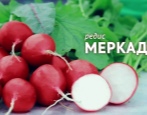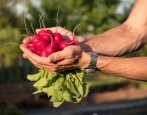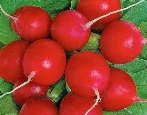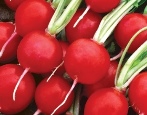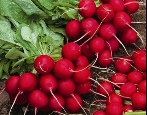
- Name synonyms: Melito
- Year of approval: 2015
- Ripening terms: mid-season
- Leaf rosette shape: semi-upright
- Leaves: short, obovate with a rounded apex, green
- Petiole: with a slight anthocyanin coloration
- The form: rounded
- Coloration: Red
- Weight, g: 20-30
- Color of the pulp: white
Growing a radish in a garden bed or in a small greenhouse is not difficult at all if you choose the right variety that quickly adapts to growing conditions and is also endowed with good immunity. These species include the mid-season Melito hybrid, bred by Dutch scientists.
Breeding history
Melito Radish is a first generation hybrid created by a group of Dutch breeders Niskerson Zwaan B. V. in 2014. The main task of the scientists was to create a variety that can grow in any climatic conditions. The vegetable crop was added to the State Register of approved for use in 2015. You can grow radishes in vegetable gardens, under a film cover, and in greenhouses.
Description of the variety
The Dutch radish is a plant with a compact, semi-erect rosette of leaves. The tops are powerful, consisting of medium-length leaves of a bright green color. A characteristic feature of the plant is a shortened petiole with a weak anthocyanin coloration. The leaves of the tops are obovate with a rounded top and weak pubescence.
A distinctive feature is the strong attachment of the tops to the root crop, which facilitates the harvesting process.
Characteristics of the appearance of the plant and root crops
Melito belongs to the group of medium-fruited species. Root crops ripen, leveled, with an attractive presentation. The average weight of a vegetable is 20-30 grams, with a diameter of 4-5 cm. The radish has a rounded shape. The ripe fruit is evenly colored in a deep red color. During washing, the vegetable does not lose color. The skin of the root vegetables is dense, but not hard, with a smooth cover and a noticeable shine. There are no flaws or other defects on the surface of vegetables.
Plucked tubers can be transported long distances, and also stored in a cool place for some time. During storage, vegetables do not crack, do not lose their taste and marketability.
Purpose and taste of tubers
The hybrid is endowed with excellent taste. The snow-white and homogeneous pulp has a dense, fleshy, tender and juicy structure without wateriness and voids. The taste of the vegetable is pleasant, slightly sweet, without bitterness and pungent notes. The peel of the fruit is also not bitter.
The harvested crop is ideal for preparing fresh vegetable salads, decorating various dishes, and eating fresh. In addition, radishes are very good for bunch production and for sale without haulm.
Maturation
The Melito hybrid belongs to the category of mid-season varieties. The growing season lasts only 20-25 days. The germination and maturation of root crops is amicable. The fastest germination and ripening occur at a temperature of + 18-22 degrees. Mass harvesting lasts 10-14 days, while it is recommended to pull out the fruits every 4-5 days.
Yield
The Dutch radish is high yielding. Up to 3.9-4 kg of juicy radish can be harvested from 1 m2. If we consider that it is possible to carry out 2-3 plantings per season, then the yields will increase even more.
Growing and care
Dutch radish is grown by seed method. When cultivating a vegetable outdoors, a number of rules must be followed. Firstly, prepare elongated grooves up to 2-3 cm deep, where seeds are sown, secondly, keep a distance between rows of 10-15 cm, and thirdly, take into account crop rotation - radishes can be planted in an area where any crops grew except Cruciferous. Sowing is carried out according to the scheme 10 / 15x2 / 3 cm. The best period for planting a vegetable is considered the beginning of April - mid-August.
Caring for the vegetable is simple, it is enough to water the plants every 5-7 days, loosen and weed the aisles to remove weeds and improve air permeability, apply top dressing 2 times per period, thin out the plantings, keeping a distance of 4-6 cm, and also protect against insect attacks and various diseases.
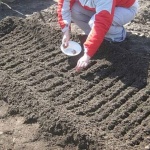

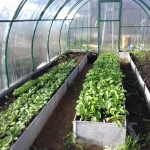
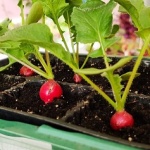
Soil requirements
The Dutch hybrid Melito, like most of its relatives, prefers loose, light, nutritious soils with low acidity and good moisture and air permeability. The culture feels comfortable in sandy loam soils. Radish develops and bears fruit poorly in heavy and waterlogged soils.
Required climatic conditions
The vegetable is quite stress-resistant, therefore it is able to withstand temperature fluctuations, mild drought and heat, but it is picky about light. It is recommended to plant radishes in flat or slightly elevated areas with a lot of heat, sun and light.
Disease and pest resistance
Melito has high immunity, therefore it is able to withstand a number of viruses and diseases, for example, downy mildew. It is also worth highlighting the plant's tolerance to root rot and rhizoctonia. Experienced vegetable growers and farmers claim that radishes are resistant to shooting.











